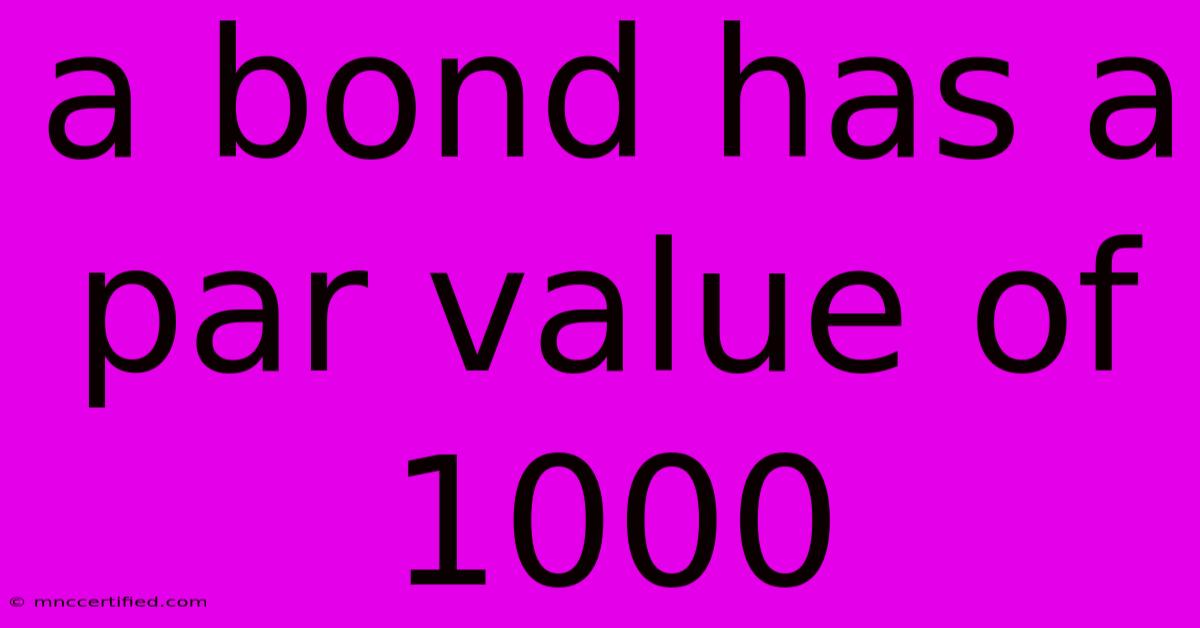A Bond Has A Par Value Of 1000

Table of Contents
Understanding Bonds: A Deep Dive into a $1000 Par Value Bond
A bond, at its core, is a loan you make to a government or corporation. In return for lending your money, you receive regular interest payments and the eventual repayment of your principal. Understanding the mechanics of a bond, particularly one with a par value of $1000, is crucial for any investor. This article will explore the key aspects of a $1000 par value bond, helping you navigate the world of fixed-income investing.
What is Par Value (Face Value)?
The par value, also known as the face value or maturity value, of a bond represents the amount the issuer will pay the bondholder upon the bond's maturity date. In this case, we're focusing on a bond with a $1000 par value. This means the issuer promises to return $1000 to the bondholder when the bond matures.
Understanding Bond Yields
While the par value represents the principal repayment, the yield is what determines the return on your investment. There are several types of yields associated with bonds:
Coupon Yield
The coupon yield is the annual interest payment, expressed as a percentage of the par value. A bond with a $1000 par value and a 5% coupon yield will pay $50 annually ($1000 x 0.05 = $50). This payment is usually made semi-annually, meaning two payments of $25 each.
Current Yield
The current yield takes into account the bond's current market price. If the bond is trading at a premium (above $1000), the current yield will be lower than the coupon yield. Conversely, if it's trading at a discount (below $1000), the current yield will be higher. The formula is: (Annual coupon payment / Current market price) x 100.
Yield to Maturity (YTM)
The yield to maturity (YTM) is the total return an investor can expect if they hold the bond until maturity. It considers the current market price, the coupon payments, and the difference between the current price and the par value. YTM is a crucial metric for comparing the potential returns of different bonds. Calculating YTM requires more complex financial formulas.
Bond Prices and Market Fluctuations
The market price of a $1000 par value bond fluctuates based on various factors, including:
- Interest rates: When interest rates rise, the value of existing bonds falls, and vice-versa. This is because newly issued bonds offer higher yields, making older bonds less attractive.
- Credit rating: The creditworthiness of the issuer significantly impacts the bond's price. Bonds issued by financially stable entities (high credit ratings) generally command higher prices than those from less stable issuers.
- Inflation: High inflation erodes the purchasing power of future payments, impacting bond prices.
- Market sentiment: Overall market conditions and investor sentiment can also affect bond prices.
Investing in $1000 Par Value Bonds
Investing in bonds can be a valuable part of a diversified portfolio, offering a degree of stability compared to equities. However, it's crucial to:
- Understand your risk tolerance: Bonds are considered less risky than stocks, but they still carry some risk, particularly with regard to interest rate changes and credit risk.
- Diversify your portfolio: Don't put all your eggs in one basket. Diversify your bond holdings across different issuers, maturities, and credit ratings.
- Do your research: Before investing, thoroughly research the issuer's financial health and the bond's terms and conditions.
- Consider professional advice: If you're unsure about how to invest in bonds, consider seeking advice from a financial advisor.
Conclusion
A $1000 par value bond is a fundamental investment instrument. Understanding its par value, yield calculations, and the factors impacting its price is crucial for making informed investment decisions. By carefully considering your risk tolerance, diversifying your portfolio, and conducting thorough research, you can effectively incorporate bonds into your investment strategy. Remember, this information is for educational purposes and does not constitute financial advice. Always consult with a qualified financial professional before making any investment decisions.

Thank you for visiting our website wich cover about A Bond Has A Par Value Of 1000. We hope the information provided has been useful to you. Feel free to contact us if you have any questions or need further assistance. See you next time and dont miss to bookmark.
Featured Posts
-
Investing In Boston Real Estate
Nov 26, 2024
-
Health Insurance Business Cards
Nov 26, 2024
-
Is Avastin Covered By Insurance
Nov 26, 2024
-
154 M Missing Macys Employee Theft
Nov 26, 2024
-
Lana Del Reys 2024 Uk Stadium Shows
Nov 26, 2024